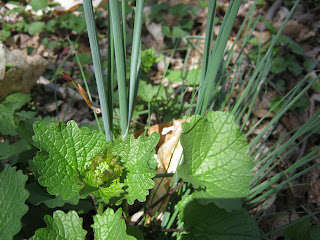 |
| A Turkey egg!! laid directly on a stone wall. |
I brought this cell phone picture back to Sue who agreed that it was a turkey egg. I have seen a female hanging out near this area for a couple of days all by herself. My guess is that she was a young (1st year) female who hadn't gotten the knack for being a Mom yet.
Another morning I passed Sue and her sister Karen on my way up to the building and they said that a Red-tailed Hawk was making passes at a couple of turkeys. By the time I made my way up there the female turkey had walked away a little but these two males near by were still strutting around.
Two Tom Turkeys trying to impress a female (out of sight just now). |
Red-tailed Hawk pair, usually seen overhead, but Monday morning found in close proximity to each other, and to us! |
"The red-tailed hawk averages 19 to 24 inches in length. There is sexual dimorphism in size: females are 25% larger than the males. Plumage ranges from light auburn to deep brown. The underbelly is distinctly lighter than the rest of the body, with a dark belly band across it. The cere, the soft skin at the base of the beak, the legs, and the feet are all yellow. The eye color of the hawk changes from yellowish gray when immature to dark brown in adults. " -Lake Milton Raptor Center
Did you guess? Based on this photo I would say the higher bird is the male although these two are very close in size. So yes the female is usually larger but everything has variation and this pair is probably made up of a larger than usual male and a smaller than usual female making them relatively close to the same size. This neighbor below was not too happy to have all this activity so close to his nest!
Northern Mockingbird in a maple. |
All photos taken by Lynn!!
West Campus birds for the week of April 16 - 20, 2012:
Wild Turkey
Canada Goose
Mallard
Great Egret
Turkey Vulture
Red-tailed Hawk
Sharp-shinned Hawk
Herring Gull
Ring-billed Gull
10. Killdeer
Mourning Dove
Rock Pigeon
Northern Flicker
Eastern PhoebeAmerican Crow
Blue Jay
Black-capped Chickadee
House Wren
American Robin
20. European Starling
Northern Mockingbird
Barn Swallow
Tree Swallow
Black-and-white Warbler
Yellow Warbler
Northern Cardinal
White-throated Sparrow
Chipping Sparrow
Savannah Sparrow
30. Song Sparrow
House Finch
American Goldfinch
Red-winged Blackbird
Common Grackle
Brown-headed Cowbird
36. House Sparrow













